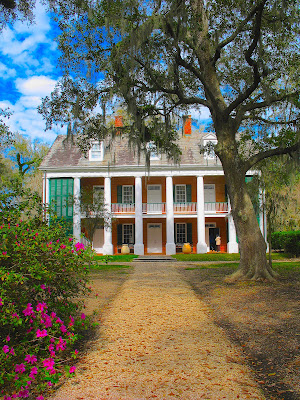 |
| Dr. Tina Theriot |
“Is that your Harley in the parking lot?” I asked Dr.Tina Theriot during my Monday morning visit to the chiropractor. It was a teasing question, and her answer startled me.
“Well, as a matter of fact, it is,” she replied. “It’s part of my new regime to scale down and have some adventures in my life. My son asked me if I was having a mid-life crisis, and I told him I’m just getting rid of stuff and having EXPERIENCES instead.”
Tina is a member of the Cajun H.O.G. organization and had just completed her first long biker ride this week-end when I talked with her Monday. She had been 127 miles with members of the 700-strong bikers, making four or five stops along the way for boudin and ending up at Poche’s near Breaux Bridge. “I’m not so fond of boudin but I loved the ride,” Tina said, giving my back a hefty push.
She often rides her Harley from her home in Youngsville, Louisiana where she says she scaled down by selling her home in New Iberia and clearing away a lifetime of accumulated “stuff” so she’d be ready for the road. We went out the back door of her clinic and walked around the shiny Harley, then persuaded her to pose for a photograph with her blond hair down, but without her helmet and the chartreuse jacket she wears for her biking trips. I wished that I shared her enthusiasm for this new adventure, but the fact that I'm in her office three days a week makes me know how foolish such an adventure would be for me.
I’m beginning to think that female chiropractors in their forties and fifties love facing physical challenges. Amy Rudder, my chiropractor in Tennessee, where I live part of the year, is a powerlifter and has won awards in international competitions as far away as Russia. She’s probably in Las Vegas right now, where she walks away with first place in her class every year. Amy, 44, and just married for the first time, can also wrangle cows and helps run the ranch her husband owns near Winchester, TN. A tall woman with enviable black, naturally curly hair who tells me that chairs and other furniture aren’t designed for short women like me, towers over me like an Amazon woman to do her magical healing. She says she likes cross-fit activities, too, but can’t take time away from her practice. However, a few months before we left Tennessee, she brought me salsa and green beans she’d preserved in her spare time away from tending cows on the week-end.
Both of these chiropractors have thriving practices and are healthy examples of healing without invasive techniques and medication; both impress me with their positive outlooks on life and confidence in their abilities to heal. At almost 83, I appreciate their efforts to make me sit up straight and to correct what years of daily writing, sitting at a typewriter or computer, has done to my spine. But more than that, I admire their adventuresome spirits during mid-life. Then again, I wasn’t such a wuss at their ages — I remember rappelling off a cliff, climbing hand-over-hand across a yawning ravine and zooming down a zip line at age 49!
Photograph by Victoria Sullivan
























